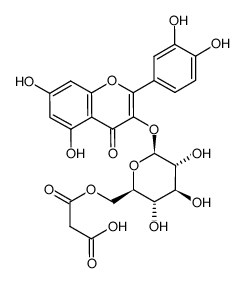Quercetin 3-O-malonylglucoside

Quercetin 3-O-malonylglucoside structure
|
Common Name | Quercetin 3-O-malonylglucoside | ||
|---|---|---|---|---|
| CAS Number | 96862-01-0 | Molecular Weight | 550.42200 | |
| Density | N/A | Boiling Point | N/A | |
| Molecular Formula | C24H22O15 | Melting Point | 195-201 °C | |
| MSDS | Chinese USA | Flash Point | N/A | |
| Symbol |

GHS06 |
Signal Word | Danger | |
|
Effect of flavonol glycoside in mulberry (Morus alba L.) leaf on glucose metabolism and oxidative stress in liver in diet-induced obese mice.
J. Sci. Food Agric. 90 , 2386-2392, (2010) Mulberry therapies on type 2 diabetic patients or streptozotocin-induced diabetic rats have been reported to improve fasting blood glucose levels. We investigated the effects of dietary consumption of mulberry-leaf powder and purified quercetin 3-(6-malonylgl... |
|
|
Identification of antioxidative flavonols and anthocyanins in Sicana odorifera fruit peel.
J. Agric. Food Chem. 59 , 975-983, (2011) Ten flavonols and three anthocyanins were identified in the fruit peel of melón de olor (Sicana odorifera), and their structures were established by spectrometric and spectroscopic (ESI-MS and NMR) techniques. One of the identified flavonols, quercetin 3-O-(... |
|
|
Effect of variety, processing, and storage on the flavonoid glycoside content and composition of lettuce and endive.
J. Agric. Food Chem. 48 , 3957-64, (2000) Eight varieties of lettuce (Lactuca sativum) and three varieties of endive (Cichorium endivia) were analyzed for flavonoid composition and content. Total flavonoid contents, expressed as units of aglycon for fresh material, were in the ranges of 0.3-229 micro... |
|
|
Mulberry (Morus alba L.) leaves and their major flavonol quercetin 3-(6-malonylglucoside) attenuate atherosclerotic lesion development in LDL receptor-deficient mice.
J. Nutr. 135 , 729-734, (2005) The effects of dietary consumption of mulberry (Morus alba L.) leaves and their major flavonol glycoside, quercetin 3-(6-malonylglucoside) (Q3MG), on the development of atherosclerotic lesions, in relation to the susceptibility of plasma LDL to oxidative modi... |